Things to Do in Bakhmaro, Georgia: Hiking, Sunsets & More
17 min readEverything you need to know about visiting the mountain village of Bakhmaro – from the best things to do (including my favourite sunset spots) to how to get to Bakhmaro and where to stop along the way.
At 1,950 metres above sea level, Bakhmaro is the highest climactic resort in Georgia and one of two popular mountain destinations in Guria Region, the other being Gomismta.
Bakhmaro is known for its A-frame cottages, spruce forests, and clean alpine air. It offers one of the best sunsets in Georgia, summer hiking and winter sports, and once a year, a thrilling Hidalgo-style horse race.
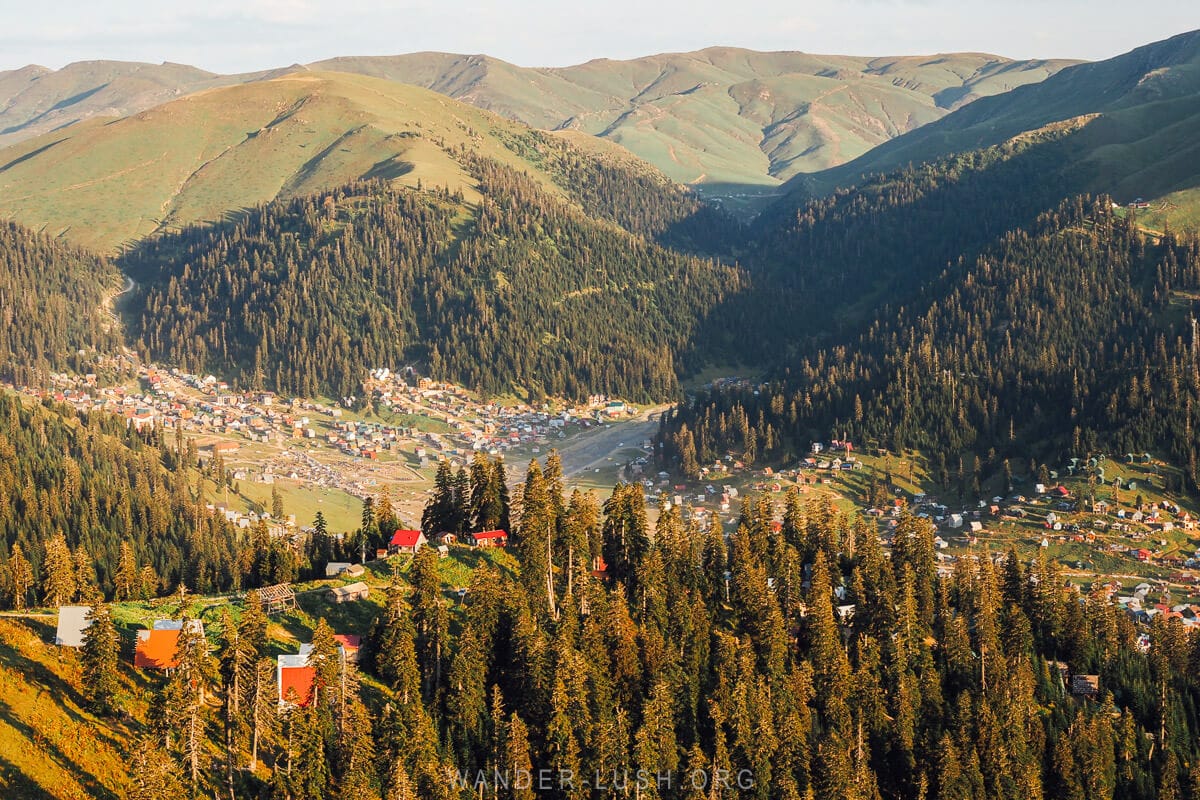
Popular among Georgians but lesser known to foreign tourists, Bakhmaro and mountainous Guria (which blends into Upper Adjara to the south) is an off-the-beaten path destination suitable. A brand new, beautifully tarred road makes it easy to get to, and there are a growing number of services on the mountain for travellers.
In this Bakhmaro Travel Guide, I will run through all the essentials, from transport logistics to the best things to do across the seasons.
Please note: This post contains affiliate links, meaning I may earn a commission if you make a purchase by clicking a link (at no extra cost to you). Learn more.
About Bakhmaro
Bakhmaro is a climactic resort located in the Meskheti Range in Western Georgia’s Guria Region. It is known for its clean mountain air, produced by a breeze rising off the Black Sea (located 50 kilometres away) that mingles with the alpine atmosphere. This sometimes condenses into a thick cotton-wool mist that floods the valleys below, giving Bakhmaro the moniker ‘Kingdom of Clouds’.
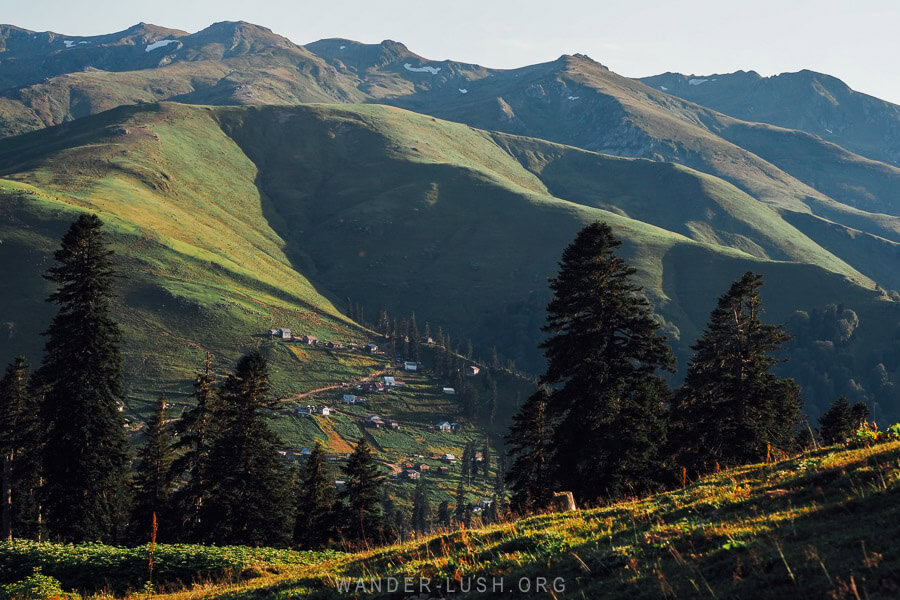
Still spring water and fizzy mineral water are both bottled in this area and sold under the names Bakhmaro and Nabeghlavi respectively. You have probably seen them sold in supermarkets.
If Bakhmaro’s air could be bottled, someone would have done it. According to locals, every deep breath in Bakhmaro boosts your immune system. They say that 21 days at the resort is enough to protect you from illness for an entire year.
In 1892, the first systematic study of Bakhmaro’s climate was performed by a local doctor. His findings came with the recommendation that people should build summer cottages on the sloping hills to benefit from the air’s therapeutic effects.
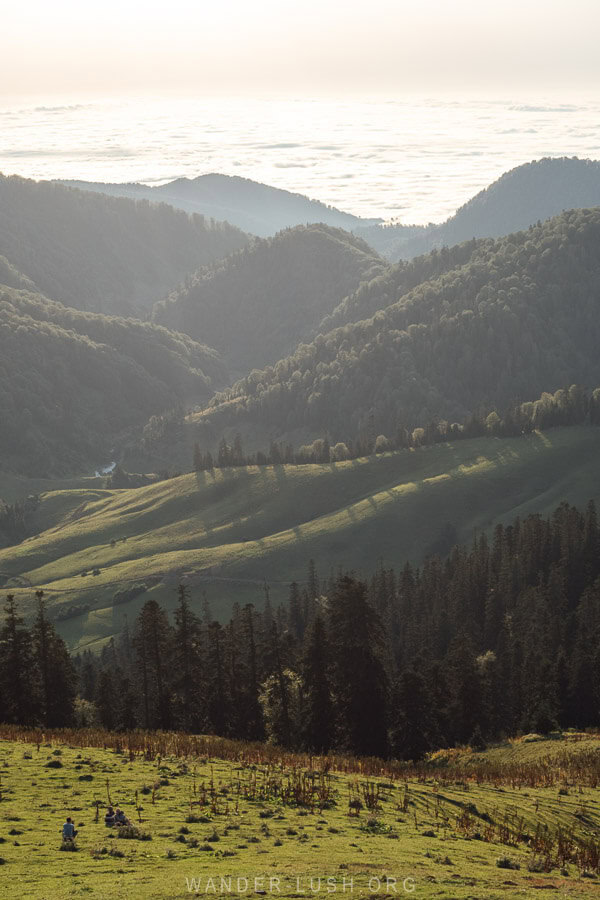
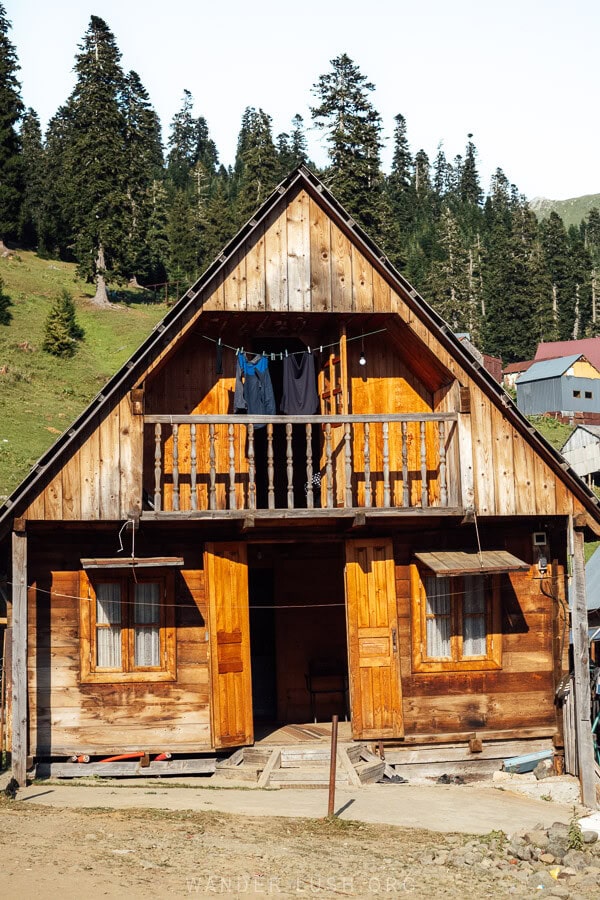
Cute A-frames – some built by holidaymakers, others belonging to Adjarian and Gurian families who summit the mountain to graze their livestock on summer pastures – dot the area. The main village sits in a basin and is surrounded by mountains. This sets it apart from Gomismta, which is located on a mountain peak.
In 2016, the Czech-run Powder Project established the first winter resort in Bakhmaro. Pioneers, their 10-room hotel and restaurant, is a starting point for multi-day hikes in the summer and for adventurous freeride skiing expeditions in winter (more details below).
Bakhmaro is the embodiment of ‘Georgian summer vibes’. In the afternoon, people gather around the little market square selling watermelons and grilling mtsvadi. At dusk, people set off enmasse for a lookout point to watch one of the most spectacular sunsets in Georgia before building bonfires and whiling the night away.
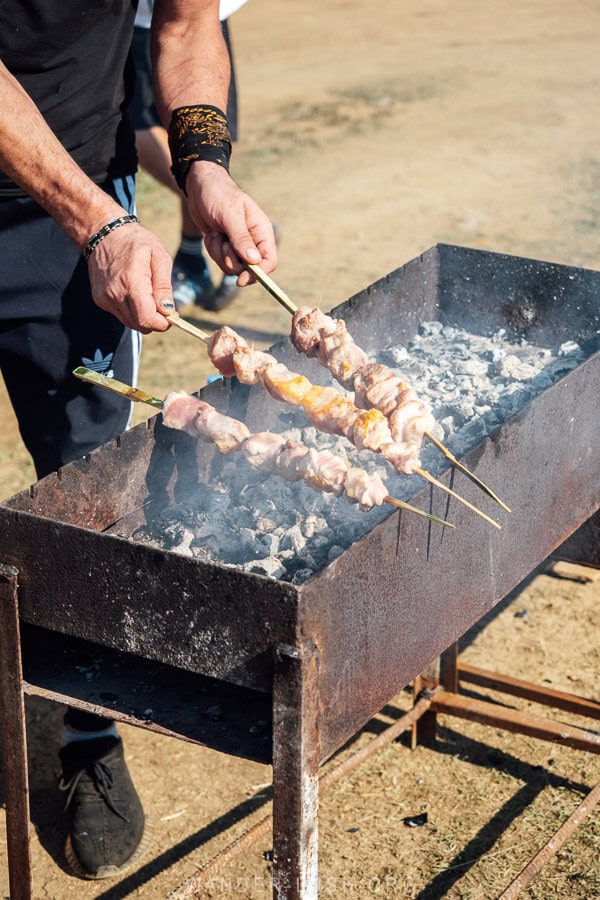
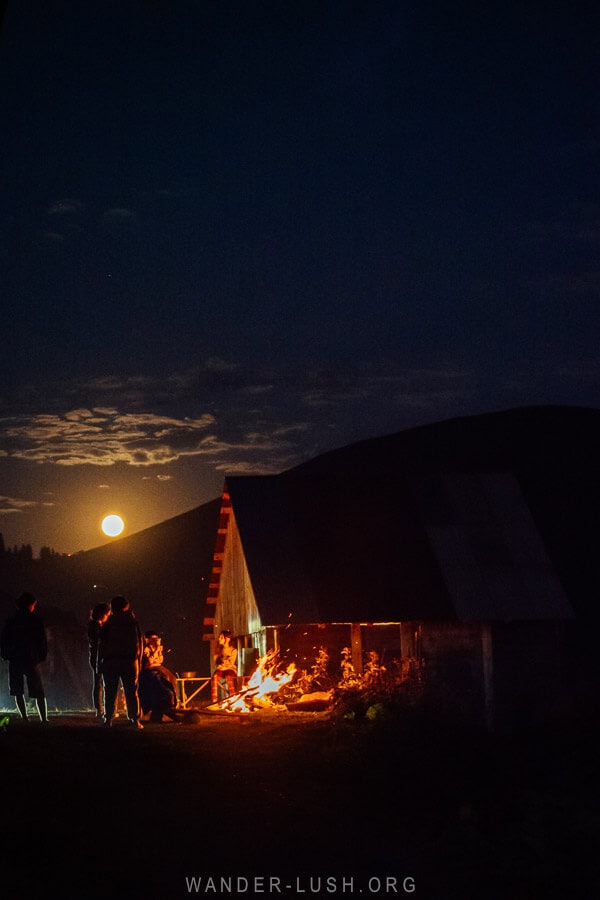
Best time to visit Bakhmaro
Bakhmaro is traditionally a summer destination with a short season. The sole access road normally opens in May, and regular transport resumes during the second or third week of June (weather depending). It remains open to traffic until the end of September.
July and August are the peak months for tourism, especially on and around August 19 when the annual Doghe horse race is held (more below). The air on the mountain is noticeably cooler at this time, but be warned that the sun is ferocious.
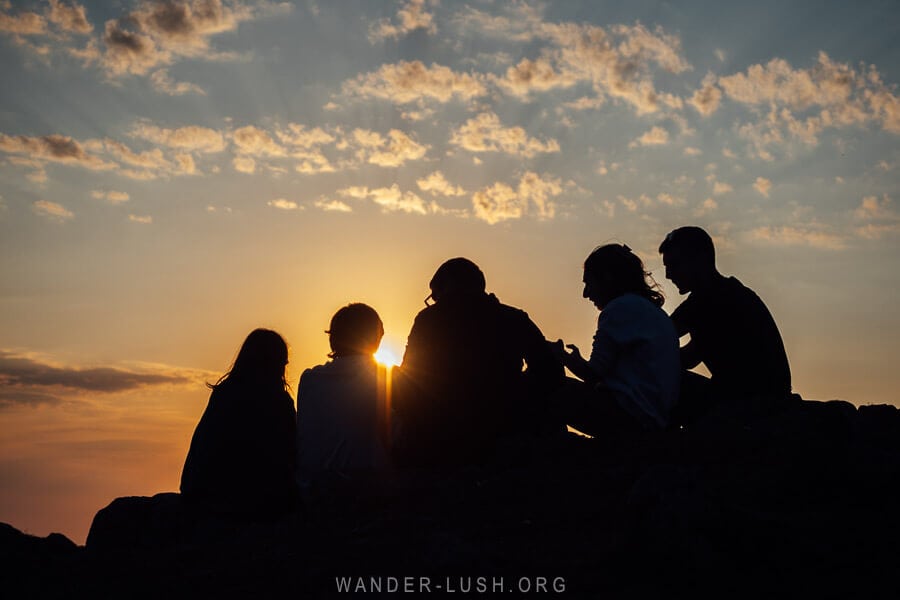
Bakhmaro’s forests are predominantly evergreen spruce and fir trees, but still there is stunning autumn foliage in this area. These photos by Levan Sikharulidze are enough to convince me to revisit Bakhmaro again in September!
The road to Bakhmaro is not maintained during winter, and is therefore closed for 6-7 months of the year. The only way to reach Bakhmaro between November and April is by snowcat. If you are interested in off-piste skiing, March is considered the premier powder month.
How to get to Bakhmaro
What is the road to Bakhmaro like?
The Bakhmaro Road is a 50-kilometre (31-mile) road that starts from the town of Chokhatauri. It is fully asphalted. Not only that, but it is smooth as silk, with freshly painted lines and safety barricades that run almost the entire length. The road is dual carriage and significantly wider than most mountain roads in Georgia. Street lights and reflective panels make it easy to navigate after dark.
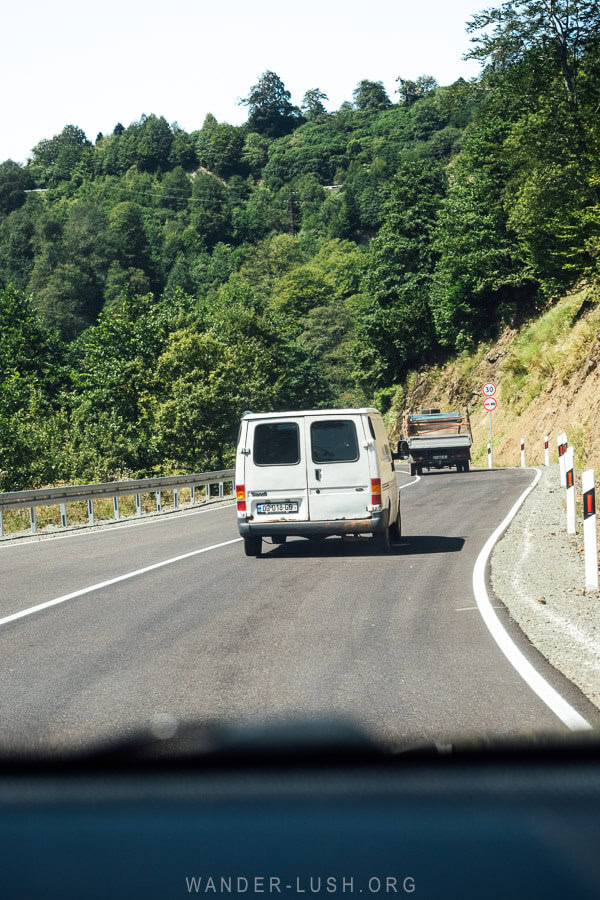
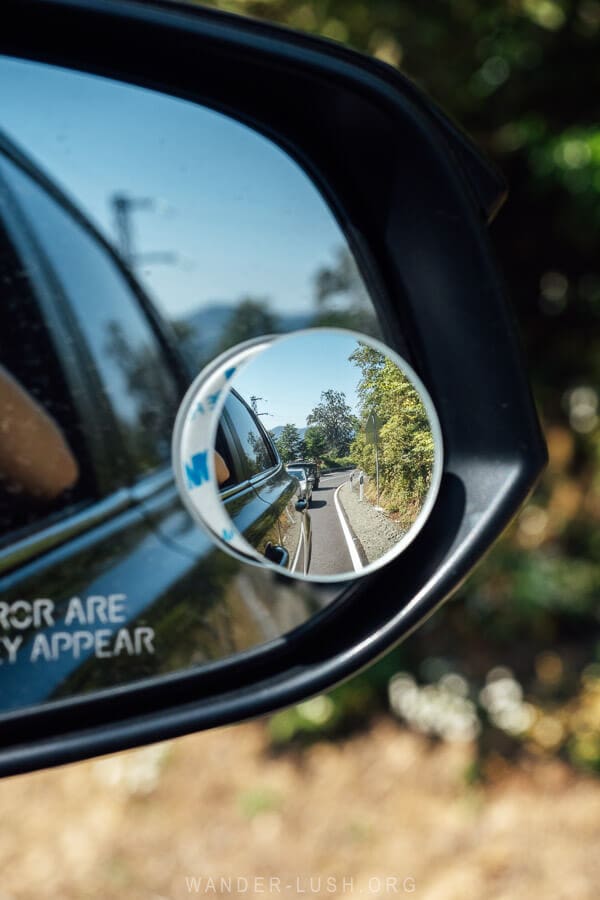
However, it is still a mountain road with lots of twists and turns. There are a few hairpin sections, but nothing too serious. The road is deceptively steep, with a steady incline almost the entire way (on our visit, we saw a dozen cars stopped on the side of the road with their bonnets up).
We drove to Bakhmaro in our RAV4. You don’t need a 4WD – any sedan will do. A few of the roads within the resort (including the way to Sunset Mountain) are unpaved and very rough, so it does help to have an all-wheel-drive if you plan to explore.
It takes around 2 hours to reach Backhmaro from Chokhatauri.
Option 1: Driving to Bakhmaro
Given the excellent road conditions and number of stops to make along the way (details and map in the next section), self-driving is the best option for getting to Bakhmaro. This road does not require any special experience or skills aside from some general Georgian driving know-how.
The start of the Bakhmaro-Chokhatauri Road is half an hour’s drive from Guria’s main city of Ozurgeti, or 90 minutes from either Kutaisi or Batumi.
There is ample free parking available inside the resort, including around the church and near the market area.
Option 2: Taxi to Bakhmaro
As always, I recommend using GoTrip to find a private driver for Bakhmaro. Transfers are available from Kutaisi (3-4 hours; from 280 GEL), from Batumi (3-4 hours; from 260 GEL), from Tbilisi (6-7 hours; from 400 GEL) – and from all other major hubs across Georgia.
Use the website to book a one-way transfer or a Bakhmaro day trip. For the latter, the driver will wait for you and take you back at the end of the day. The price (per car) is locked in and won’t change – and you are free to make as many photo/sightseeing stops along the way as you like.
Option 3: Marshrutka to Bakhmaro
Public transport (shared marshrutka vans) run during the summer high season, approximately between the middle of June and the end of September.
Direct vans are available from Chokhatauri, Ozurgeti or Batumi.
In Chokhatauri, vans leave from the market area near the turn-off for the Bakhmaro Road. I don’t have a timetable, but if you ask around, locals will be able to point you in the right direction. Shared taxis should also be available, especially in the morning.
In Ozurgeti, there is a once-daily van departing at 12 midday from this small bus station in the centre of town. When you arrive in the courtyard area, you will see the office where you can purchase tickets. Travel time to Bakhmaro is around 2.5 hours, and the fare is around 15 GEL per person. The same van departs Bakhmaro for Ozurgeti daily at 4pm. Contact the driver, Dato, on +995 551 01 92 92.
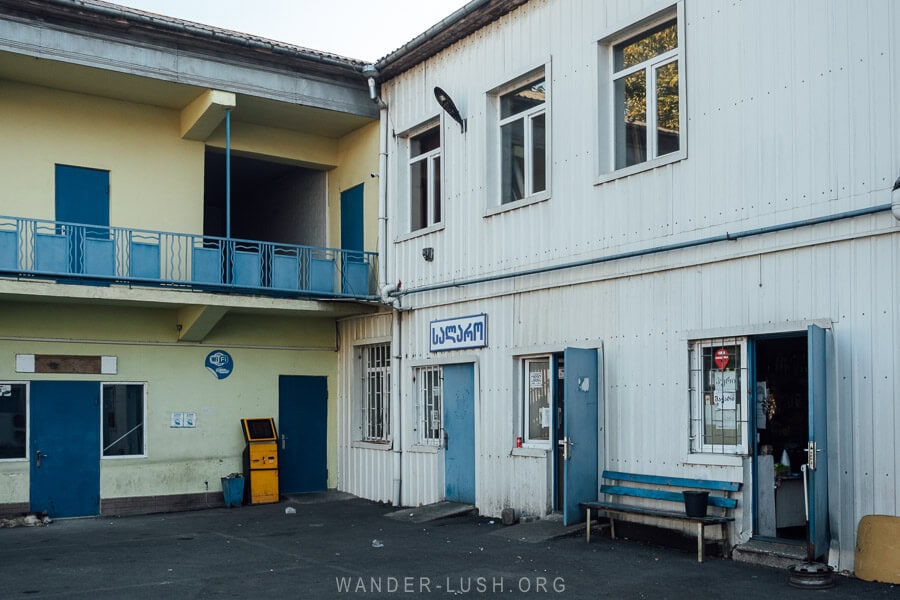
In Batumi, a once-daily van departs from Central Bus Station at 7.30am. Travel time to Bakhmaro is 4-4.5 hours, and the fare is around 25 GEL per person. It then departs Bakhmaro to return to Batumi at 1.30pm. Arrive at least 40 minutes early to secure a spot. Contact the driver, Jemal, on +995 599 33 03 12.
There is no direct marshrutka to Bakhmaro from Tbilisi. If you are coming from the capital, you should plan to change vans in Ozurgeti or Chokhatauri.
Map of Bakhmaro
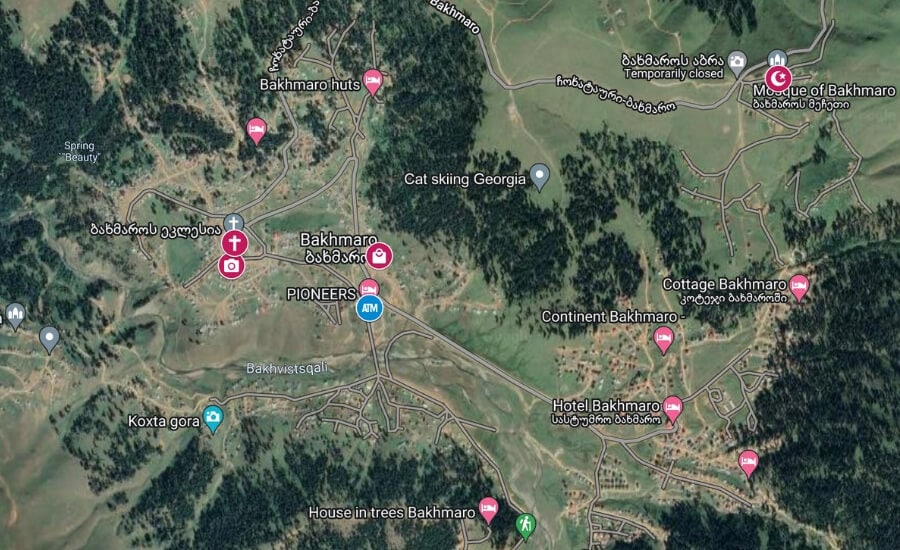
Things to do in Bakhmaro
Admire the colourful cottages
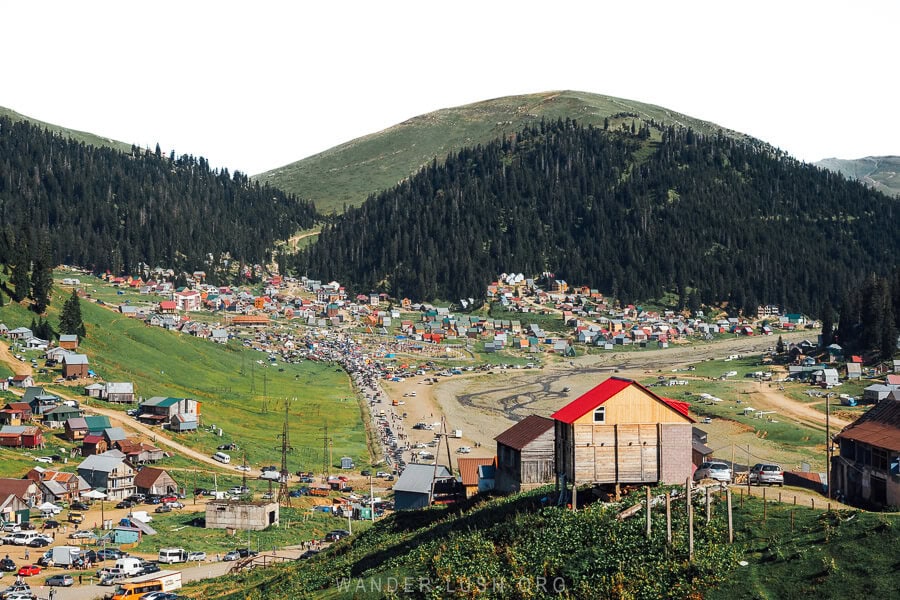
Over the past five years, I have watched the A-frame cottage trend take off across Georgia. Well, Bakhmaro was doing A-frames before they were cool!
The entire valley is sprinkled with little bungalows, some in clusters around the market area and others sitting solo on remote hills. Patched together from tiber, corrugated iron and whatever else, each one has a different colour scheme.
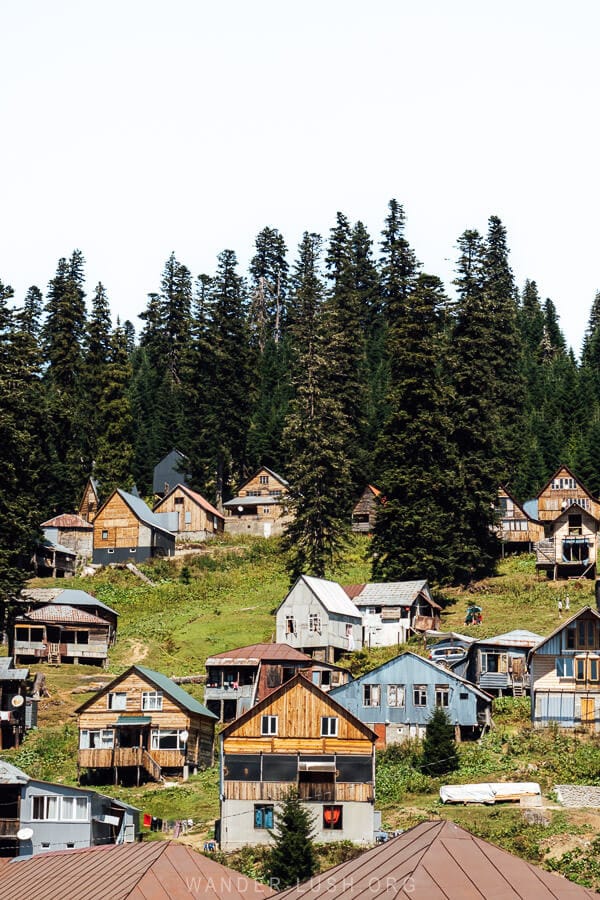
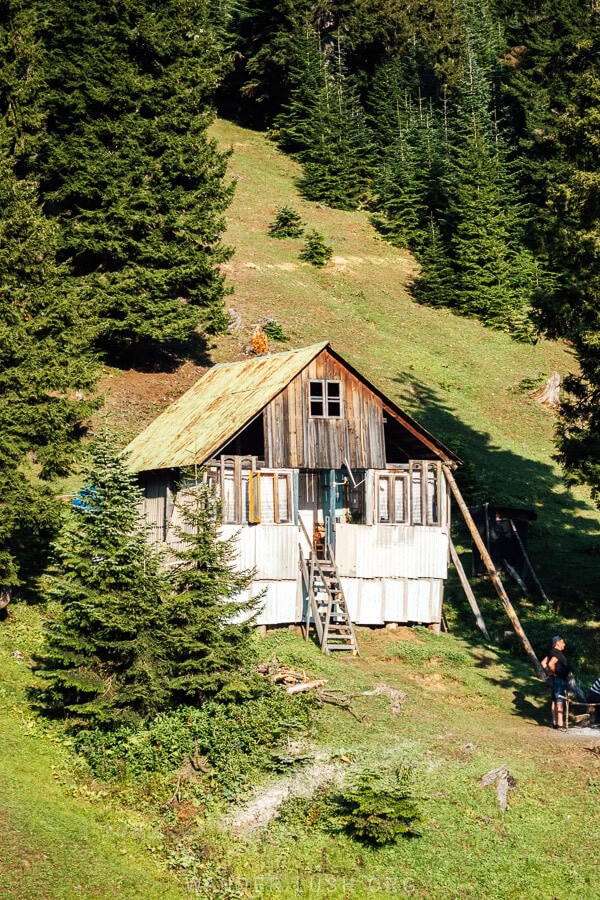
Some have been painted in shades inspired by the spruce and fir trees, while others are humbly beautiful because of their well-weathered wood or metal sheets with an interesting rust patina.
Some of the older wooden structures are leaning on unbelievable angles. Many are ramshackled and apparently illegal constructions. Each one has its own outhouse.
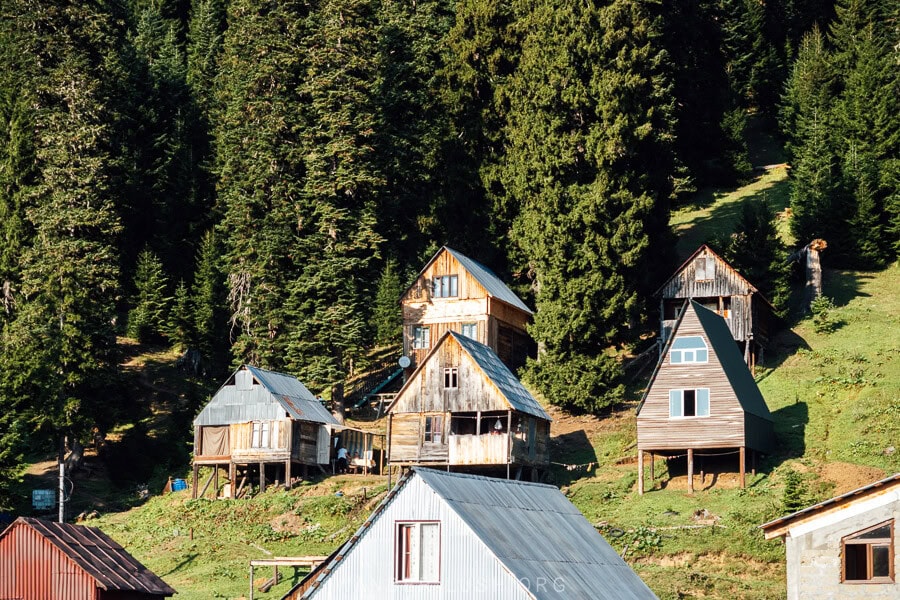
Because of the way Bakhmaro is laid out, you can get some great views/photos of the cabins tiered over the hillsides. I took these photos on the road up to the church from the market.
There are half a dozen exceptionally beautiful summer houses directly behind the church on Makharadze Street. These ones are more grand, with big balconies and intricately carved wooden features. Unfortunately I missed out on a photo!
Visit the Bakhmaro Church
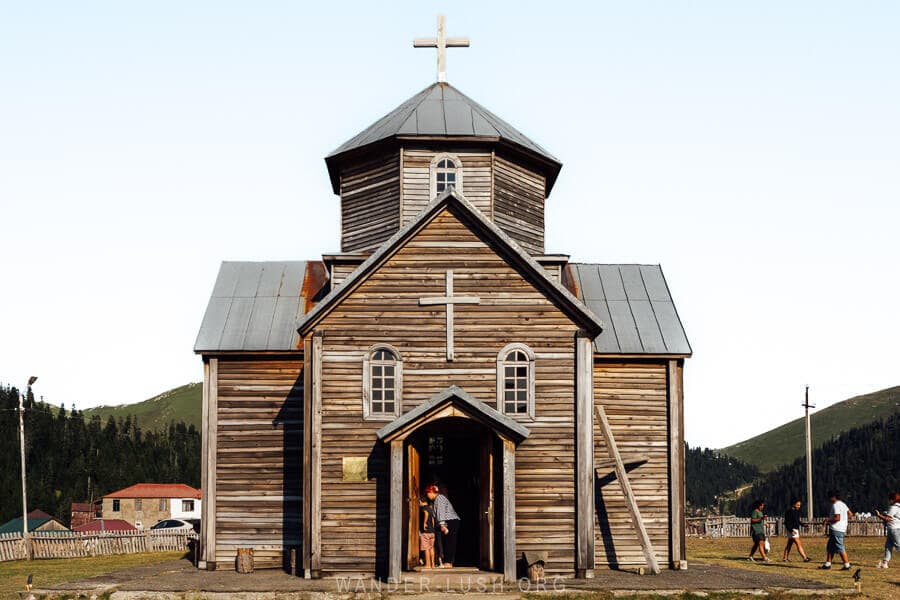
Located in the upper part of the village, Bakhmaro Church is perfectly aligned with the vernacular cabin architecture. It too is crafted from wood, both inside and out.
The church was built in 1997 and is a stellar example of the craftsmanship Bakhmaro is known for. Local woodworkers are responsible for the design, which features an interesting all-wood cupola pieced together from flat panels to give it a rounded shape. The walls are plastered with icons, and a chandelier hangs overhead.

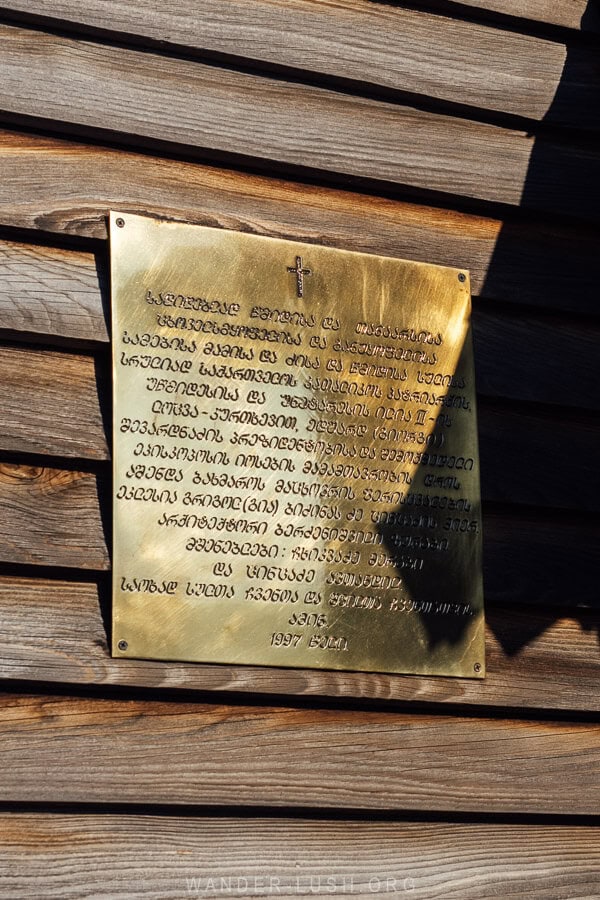
This part of Georgia is quite diverse. Bakhmaro also has a mosque, located at the start of the village.
Buy a wooden souvenir
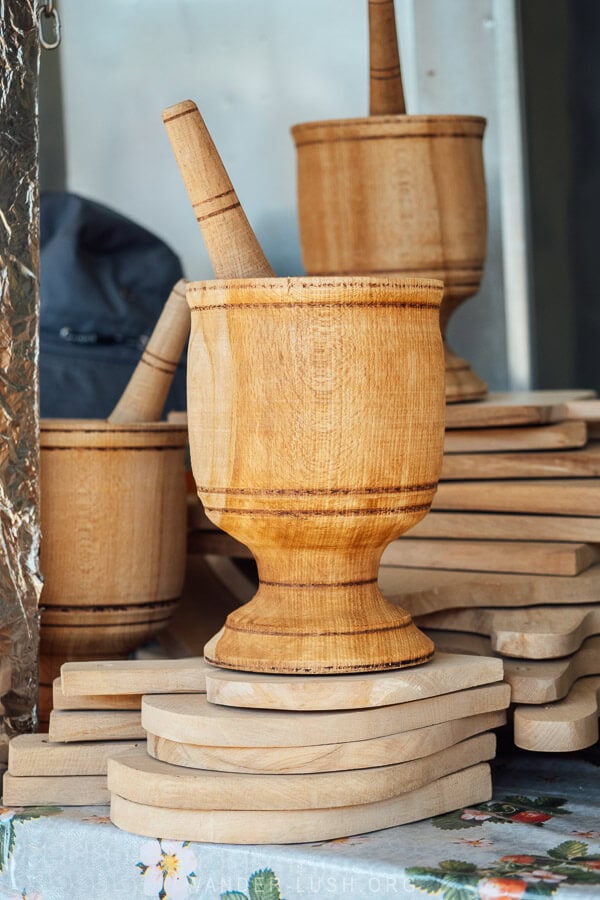
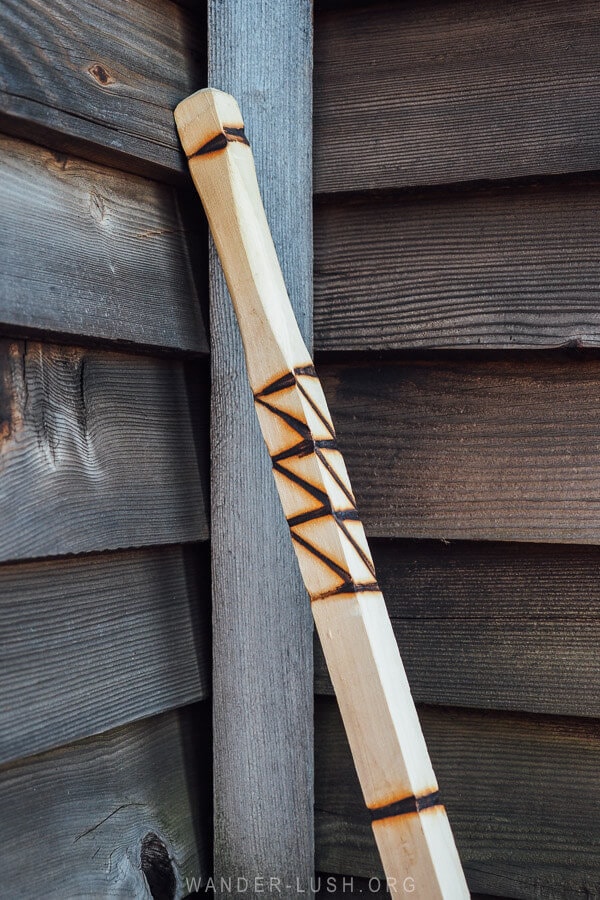
You can take a piece of Bakhmaro mastery home with you by picking up a locally made wood souvenir. The little shops around the market square all sell different whittled items, ranging from miniature rocking horses and baby’s cradles (just like the ones I saw in Gjakova in Kosovo, only much less ornate) to spoons and mortar and pestles.
One item you can buy here that I haven’t seen anywhere else in Georgia is a wooden walking stick or ‘trosti’ (above right). I noticed a few people in the village were using them, so we made a special trip back down to the market to buy a pair. I’m glad we did – I love our little trosti! And they come in very handy if you plan to hike to sunset mountain (see below).
The sticks each have a different geometric design burnished on the handle. We paid 5 GEL for ours.
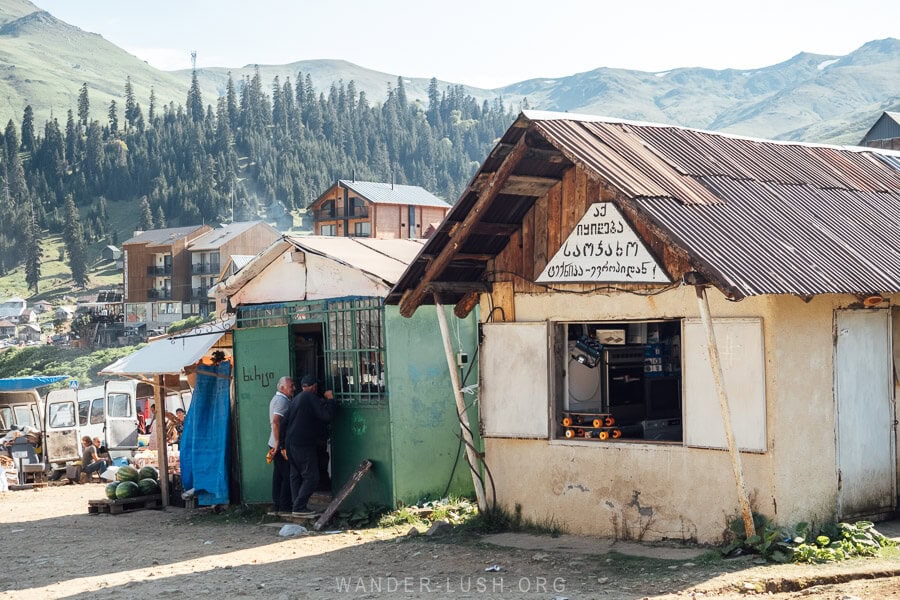
Another unique product you can find in Bakhmaro is spruce chewing gum. Similar to the pine chewing gum you find in Borjomi, it is made from tree resin and has a fragrant taste of the forest.
Eat lunch at Pioneers
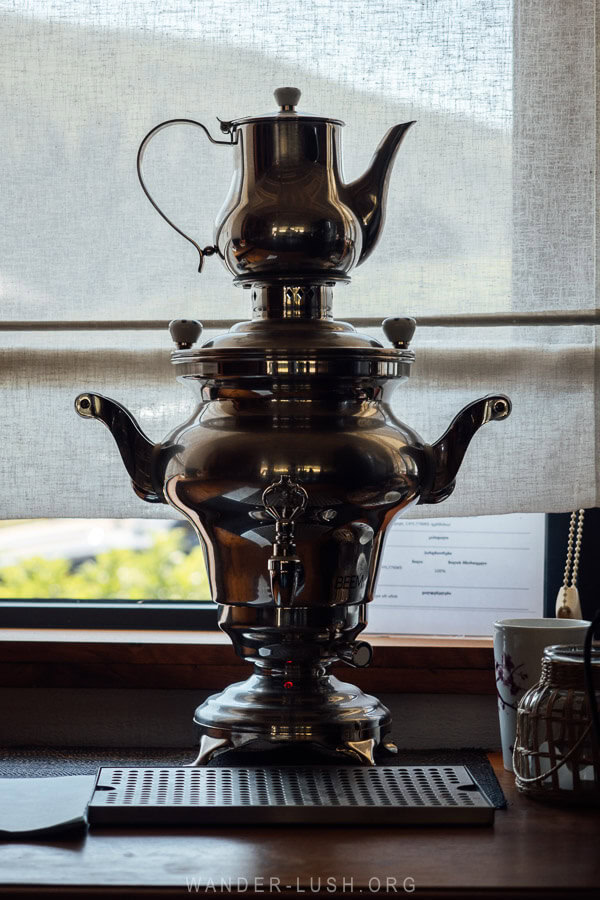
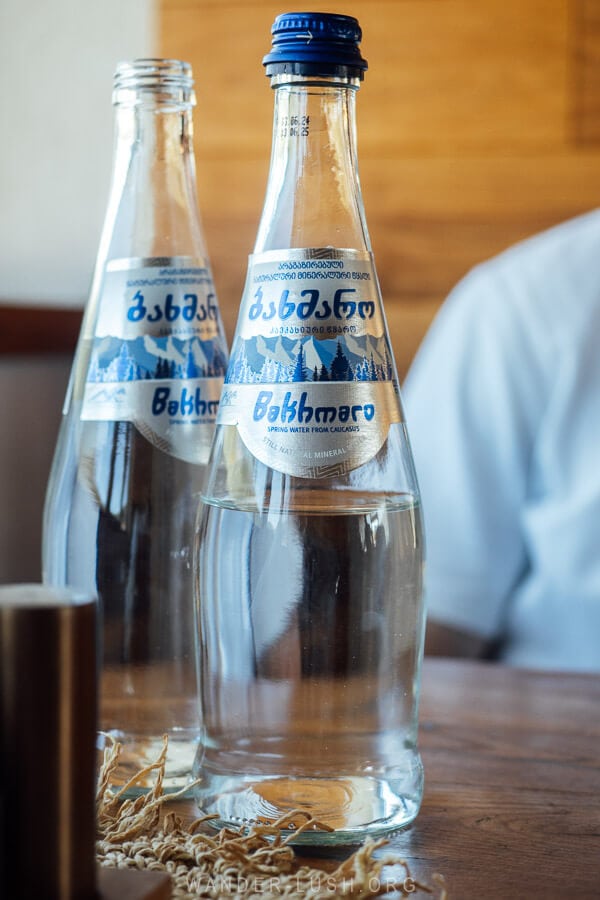
There are a handful of cafes and restaurants in Bakhmaro, most of them set up inside traditional cabins. Since we weren’t planning to spend the night on the mountain but wanted to check out the legendary Pioneers, we decided to eat lunch at the hotel restaurant.
Located on the hill between the church and the valley, Pioneers has a terrific view. Whether you’re visiting for lunch or dinner, I recommend sitting on the terrace so you can take in the full panorama.
Prices are very reasonable, and the menu is very comprehensive. If it’s available, you can try kaymaghi, a local clotted cream cheese analogous to kaymak found in Turkey and the Balkans. We broke with tradition and ordered burgers for lunch. Hand on heart, the cheeseburger here is definitely in my top five in Georgia.

It must also be said that the service here is exceptional – even on the busy Bakhmaro Cup day, staff were attentive, patient and professional.
Attend the Bakhmaro Cup horse race (August 19)
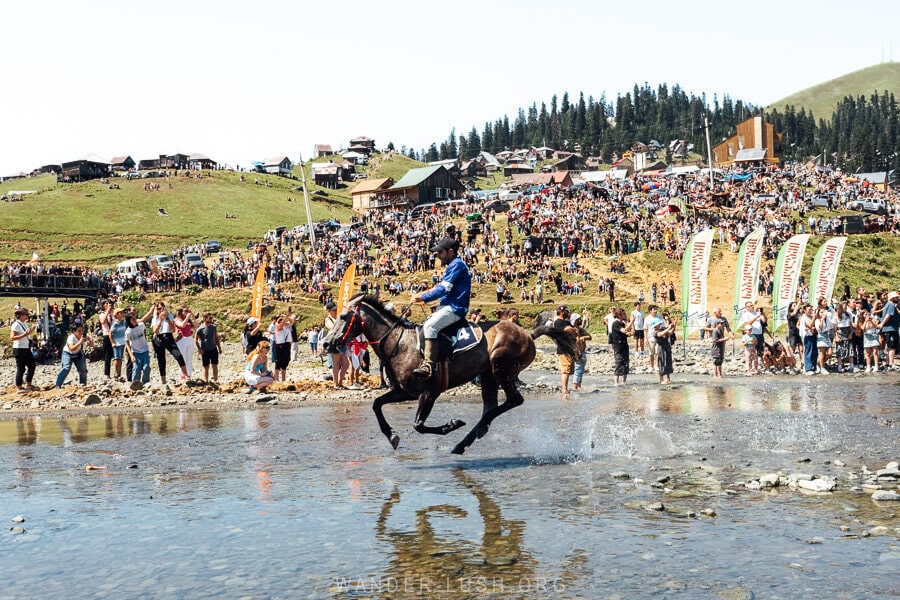
If you happen to be travelling through this area in August, it is worthwhile planning your visit to Bakhmaro around the Bakhmaro Doghe or Bakhmaro Cup. The century-old horse race and festival takes place every year on the Feast of the Transfiguration, August 19.
Thousands of people from the surrounding villages and towns travel to Bakhmaro to watch riders vie for one of four cash prizes.
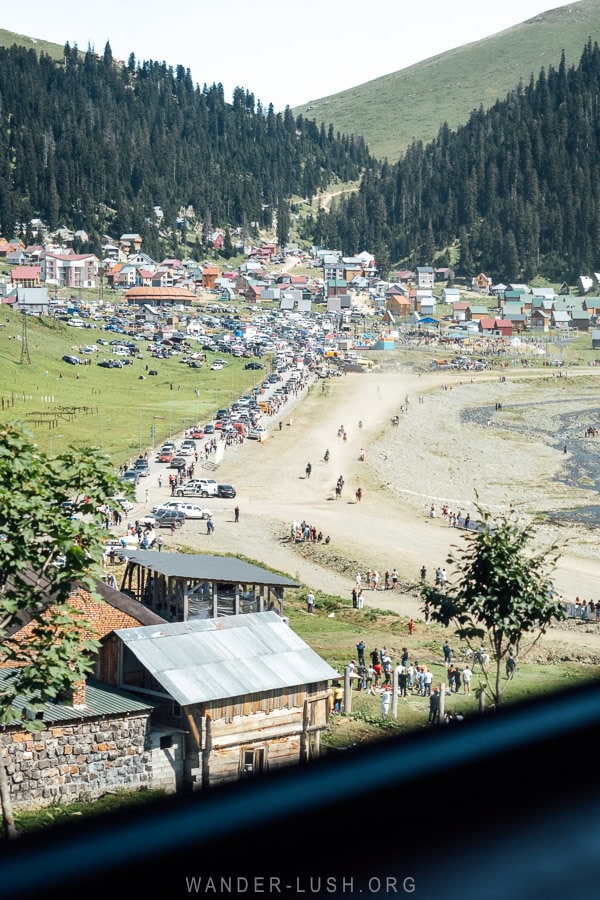
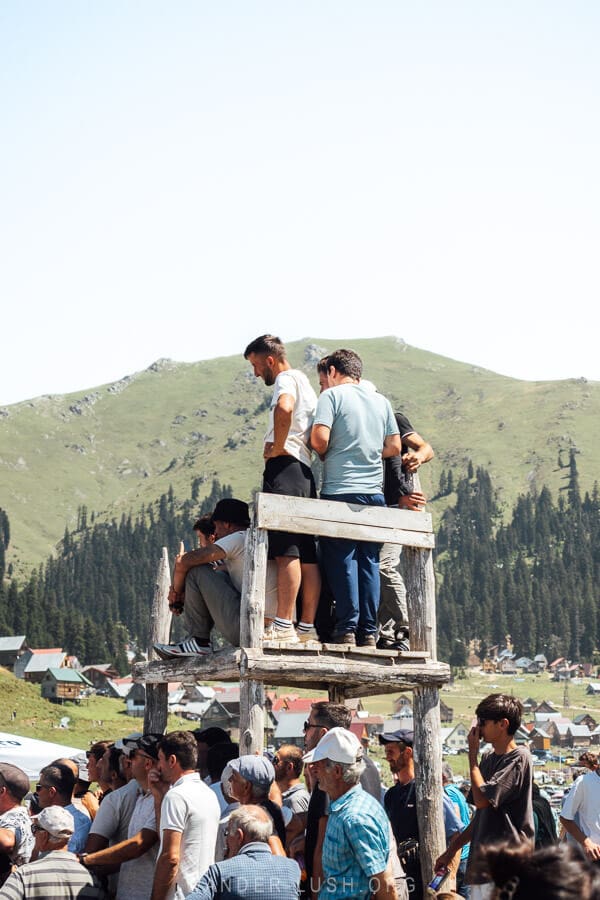
This was my first horse race in Georgia – or anywhere for that matter – and it was nothing like I expected. The circular route is part track (road), but mostly riders gallop along the river’s edge.
The race kicks off at 2pm, inaugurated by the local priest who makes his way down to the starting line after presiding over Transfiguration Day mass up at the church.
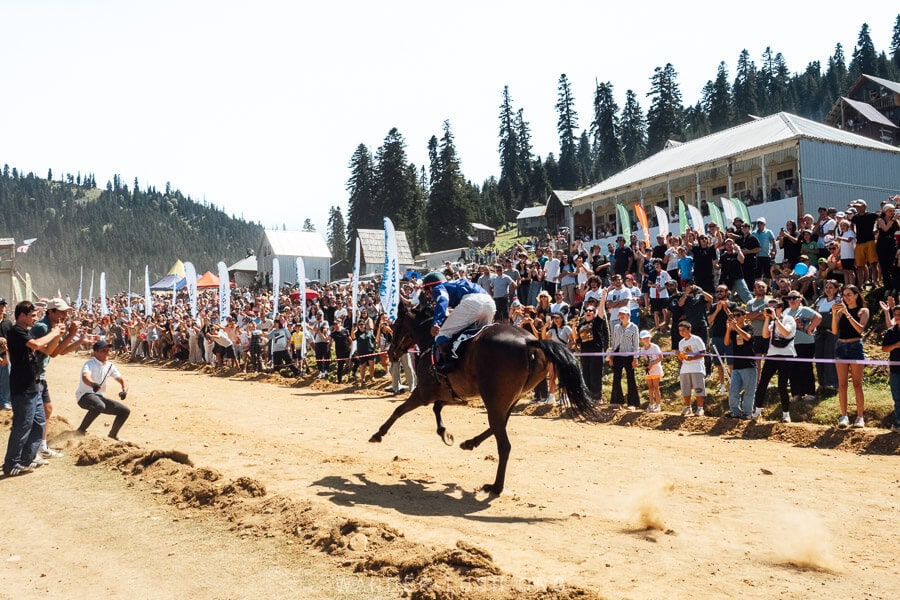
Between six and 15 local riders of all ages take place in each of the four races. There is no starting stall – jockeys congregate at the elevated barricade above the river and set off in an anticlockwise direction, running along the water’s edge then crossing near the bridge before finishing in the same spot.
There is a short break between each heat so you can change your position to watch each race from a different angle. We watched the first couple from the river (I recommend wearing sandals so you can easily wade across the shallow water to get a good vantage) then the final race from the finish line.
All up, the event lasts for about 40 minutes.
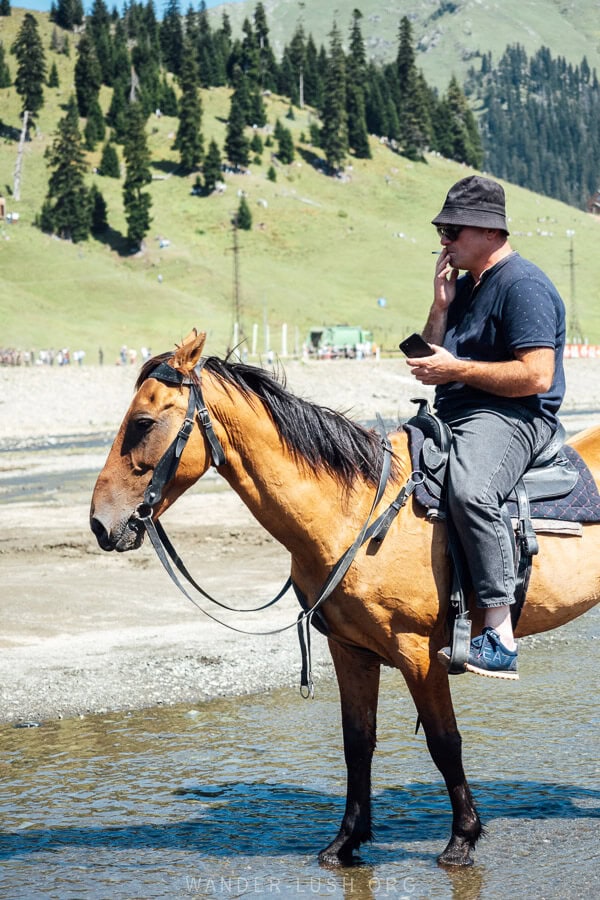
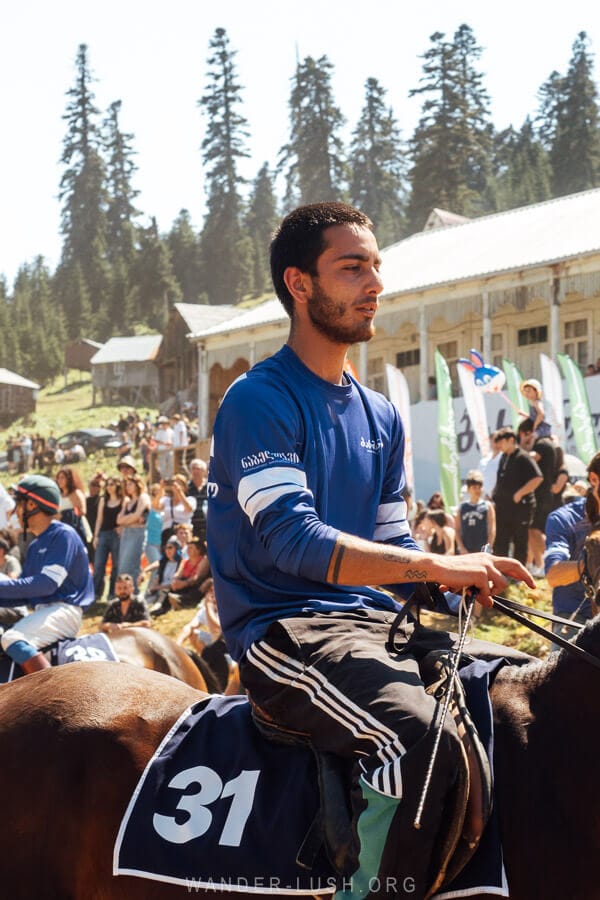
Not unlike Guria’s other famous festival, Lelo Burti, the Doghe is a bit of a free for all. People constantly run across the raceway (roped off with nothing more than a piece of ribbon) and we saw a couple of near misses where pedestrians almost collided with the geed up horses. We also saw two riders come off mid-race, one of whom was seriously injured.
Guria has a long and proud tradition of horsemanship, and races are taken very seriously – read more about the history in my Guria Guide. Outside of Cup season, you will see horses all over Bakhmaro. Short trots through the resort and more comprehensive horseback excursions can be organised locally.
Hike to Sunset Mountain at golden hour
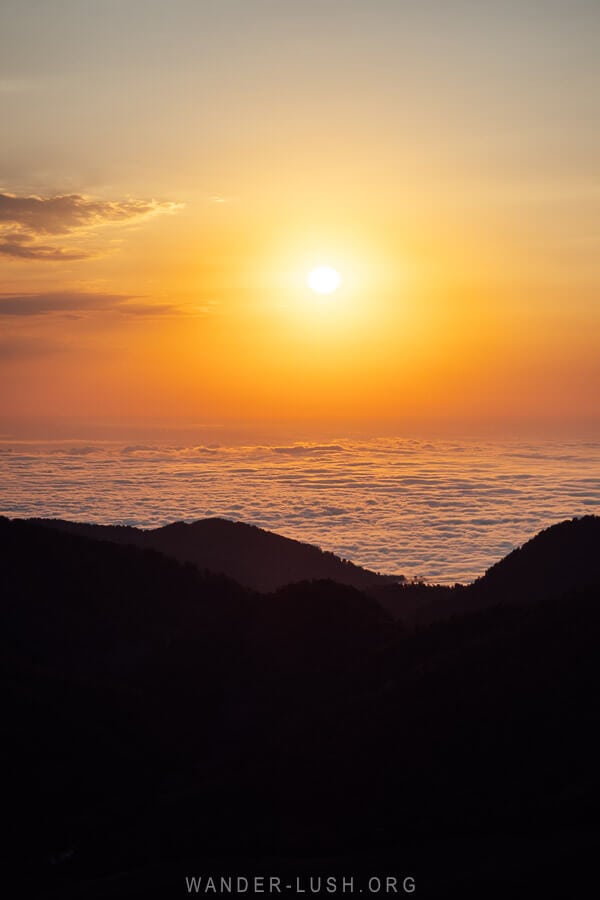
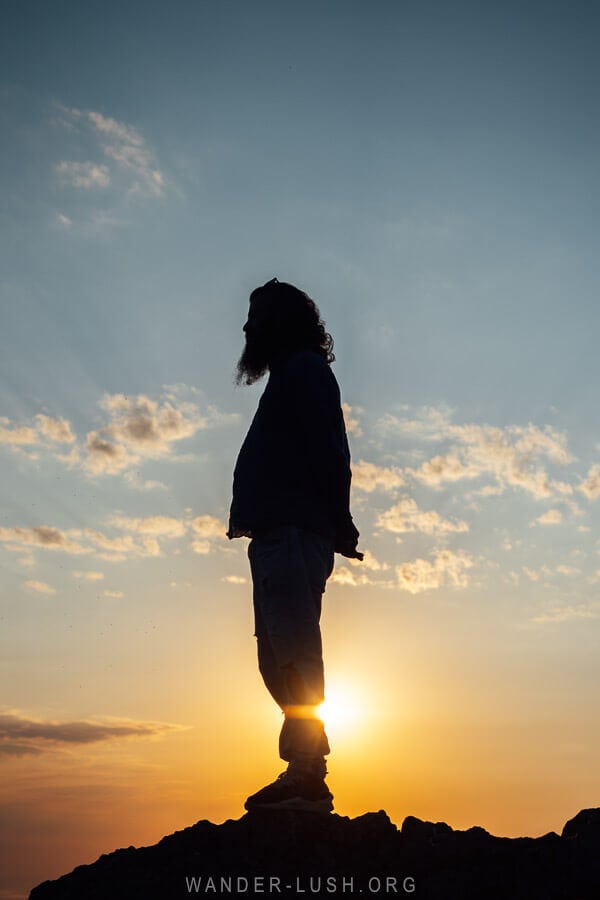
The best thing to do in Bakhmaro any day of the year is to hike to the famous Sunset Mountain. I say ‘hike’ because it does take some exertion to get up the hill via the very steep, very uneven road.
The easiest to reach of several west-facing viewpoints in Bakharmo, this one (at 2,170 metres above sea level) is located around 1.5 kilometres from the church. To get there, follow the stairs up between the houses then join up with the road and follow it until the end. The lookout point is located on a plateau and marked with a big metal cross.
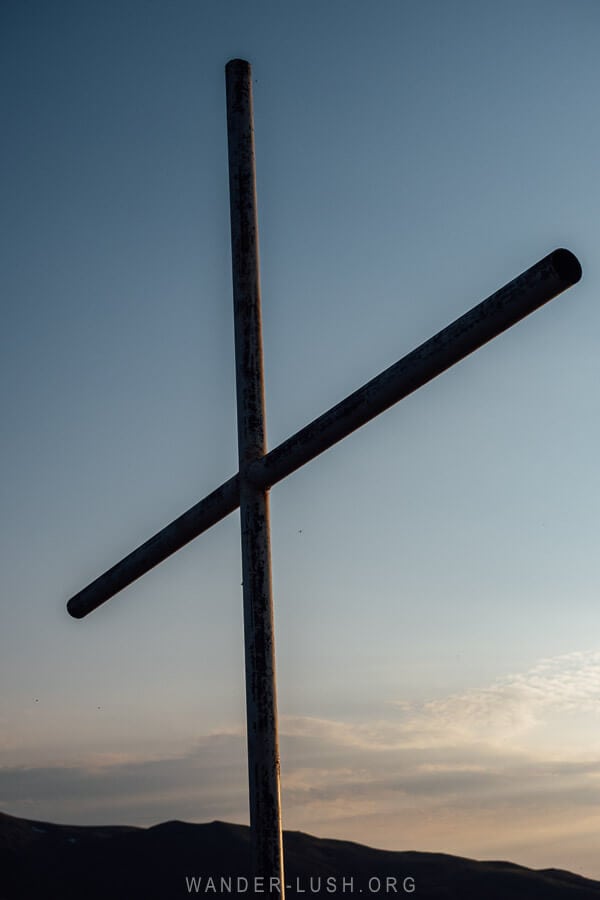
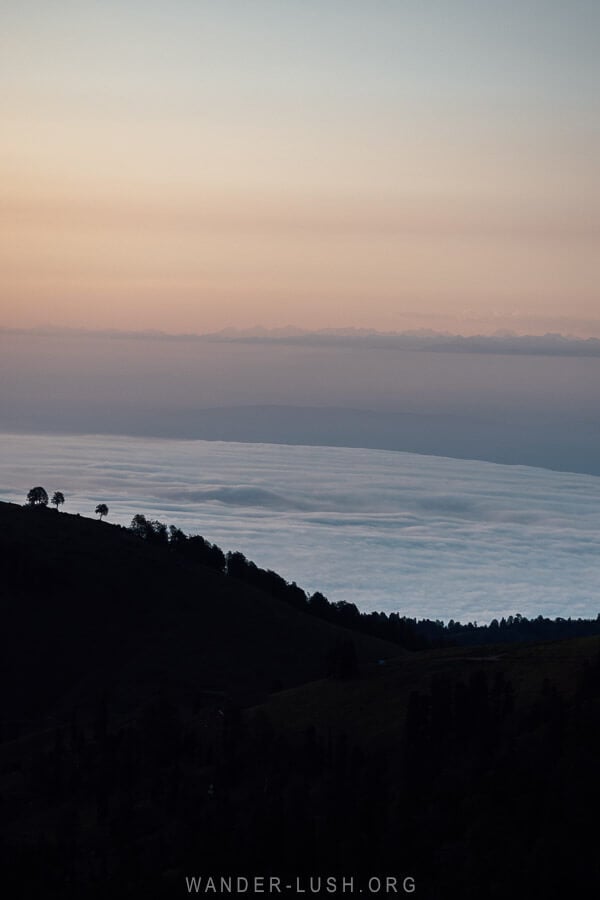
The climb is made somewhat easier by the beautiful scenery and charming houses you see along the way.
I was absolutely gobsmacked by the views when we arrived. As difficult as the walk was, it was totally worth it. Looking down into the valleys through silhouetted mountain peaks, a thick mist appears between the mountains. If it’s clear, you will see the sun set right into this sea of clouds, throwing streaks of colour across the skies.
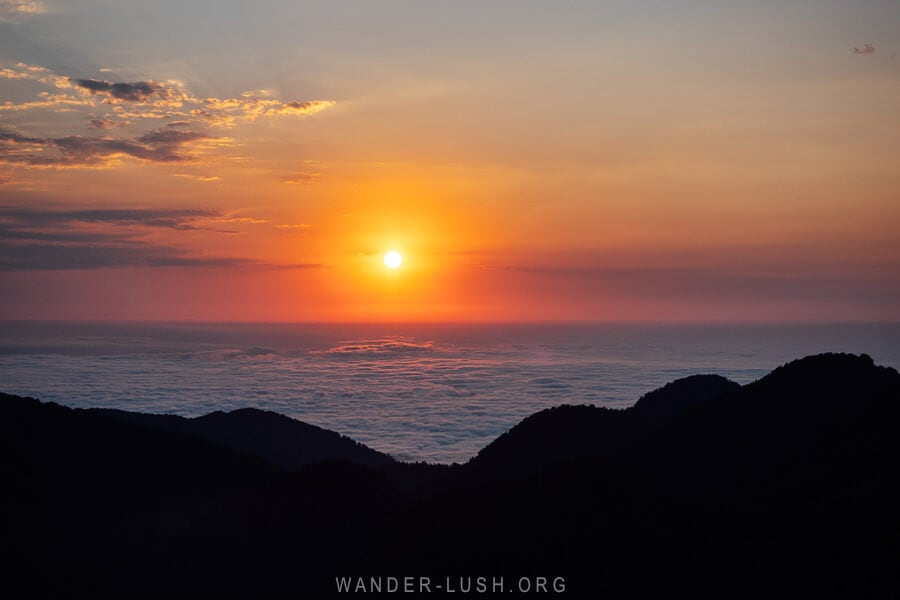
On Transfiguration Day there were plenty of people up at the viewpoint, some picnicking and cooking BBQ pork over little open fires. The atmosphere was terrific.

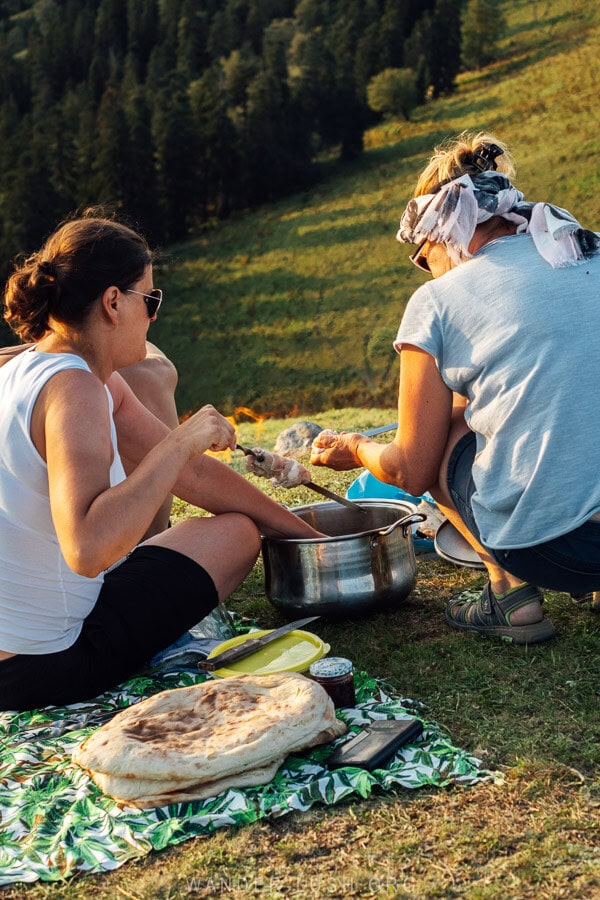
Since we had our car, we decided to drive as far as we could. We ended up parking before the steepest section of the road, around this point. Even the first section was a challenge, so unless you have a very, very robust car and off-roading experience, this is the furthest you should go.
Local drivers taxi people up and down for sunset – a seat will set you back around 60-80 GEL return. You can find drivers outside the market and near the church.
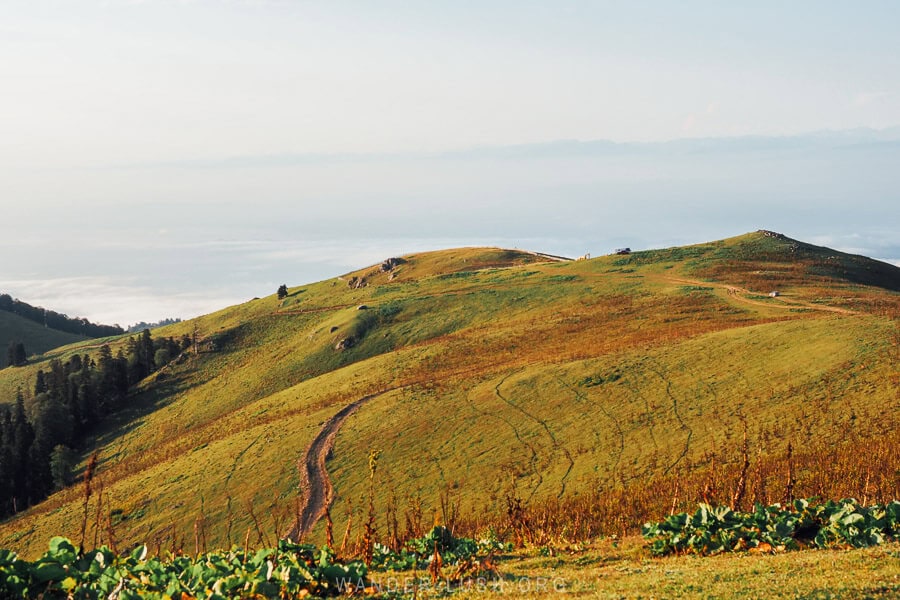
If you are walking from the church, I recommend giving yourself at least an hour to reach the peak. Try to arrive a good 40 minutes before sunset.
Alternative sunset spots can be found on the more remote Sakornia Mountain.
Stay for the sunrise
If you are overnighting in Bakhmaro, you should plan to complete the 4.5-kilometre hike to Gadrekili Mountain, known locally as the ‘sunriser’. It faces east and affords a beautiful dawn panorama of the sun emerging over the mountains.
The viewpoint is located at an elevation of 2,505 metres and the path up is a lot more challenging – thus it is only recommended for experienced hikers. To see the daybreak you will need to walk in the dark, departing Bakhmaro 3-4 hours before sunrise.
Hiking in Bakhmaro
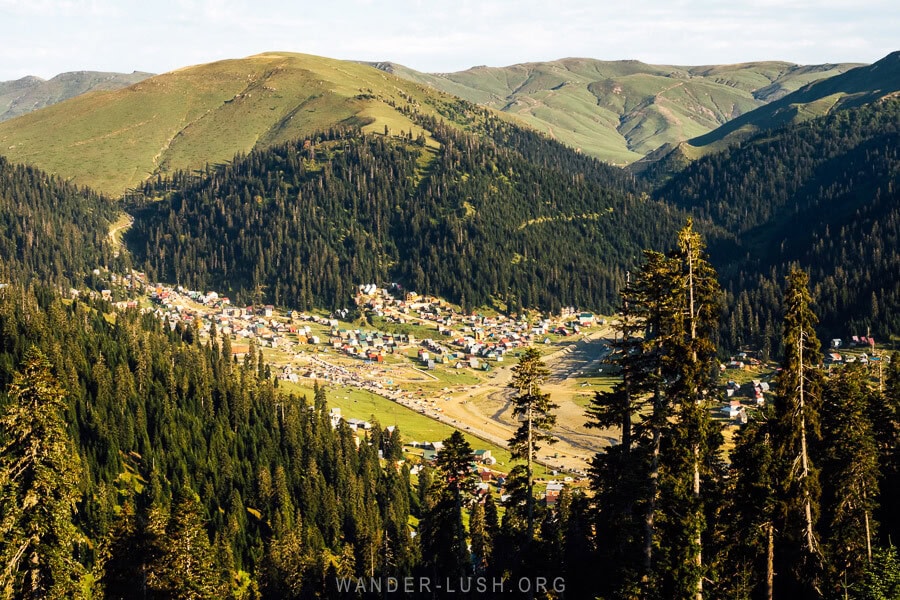
There are plenty of hiking opportunities in Bakhmaro on trails that lead to different peaks and scenic viewpoints. Pioneers has a list of single-day hikes on its website, plus descriptions of multi-day hikes that run from the resort to Gomismta in Guria and even the Goderdzi Pass in Ajara region.
Skiing in Bakhmaro
For all things skiing, snowboarding and splitboarding in Bakhmaro, defer to the Powder Project (the group behind Pioneers). This Czech project is literally trailblazing winter sports in this part of Georgia and produces a lot of useful information on the topic.
With no ski lifts and only basic infrastructure, Bakhmaro is only recommended for advanced skiers who are comfortable with backcountry or off-piste conditions. Other activities such as cat skiing and hiking in traditional 19th-century banduli snowshoes are also on offer.
For a more entry-level skiing experience in Georgia, I recommend heading to Gudauri Resort, close to Tbilisi. See my detailed tips for visiting Gudauri before you go.
More things to do (where to stop on the way to Bakhmaro)
If you have your own transportation, there are a handful of worthwhile stops on the way to Bakhmaro from the lowlands.
Stop off at the Chokhatauri Sunday Farmers’ Market
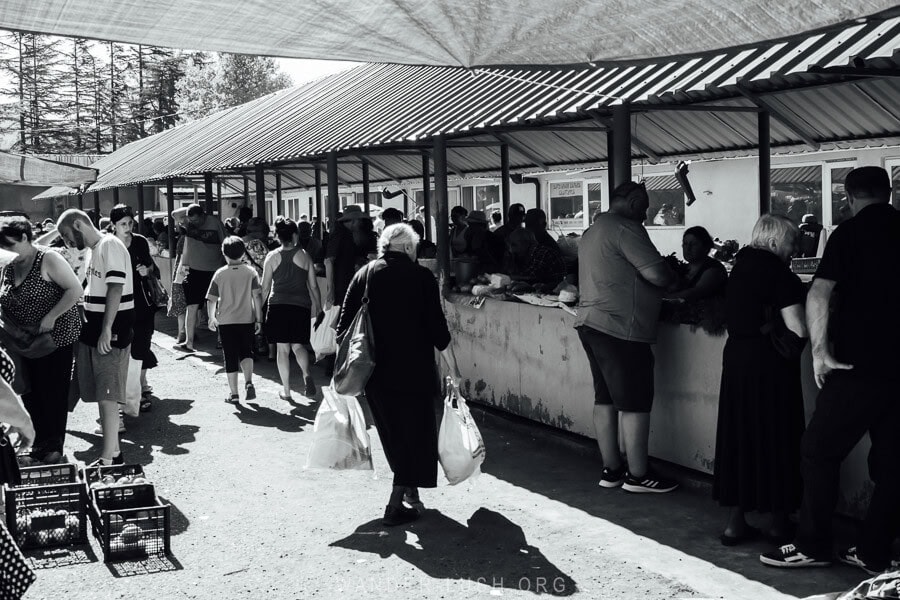
I love Georgian bazaris, but I am only just now cottoning onto the Sunday farmers’ market experience. These once-a-week pop-up bazaris are normally held in smaller communities where there is no need for a daily market, and see people from the surrounding villages congregate to shop, sell and trade.
The Chokhatauri Sunday Bazaar was my first Sunday bazari, and what an introduction! Unfurling on the streets and inside specially constructed pavilions right at the head of the Bakhmaro Road, it offers an assortment of fresh fruit and veg, spices, locally produced tea and tobacco plus live animals (not something you see at your average city market).
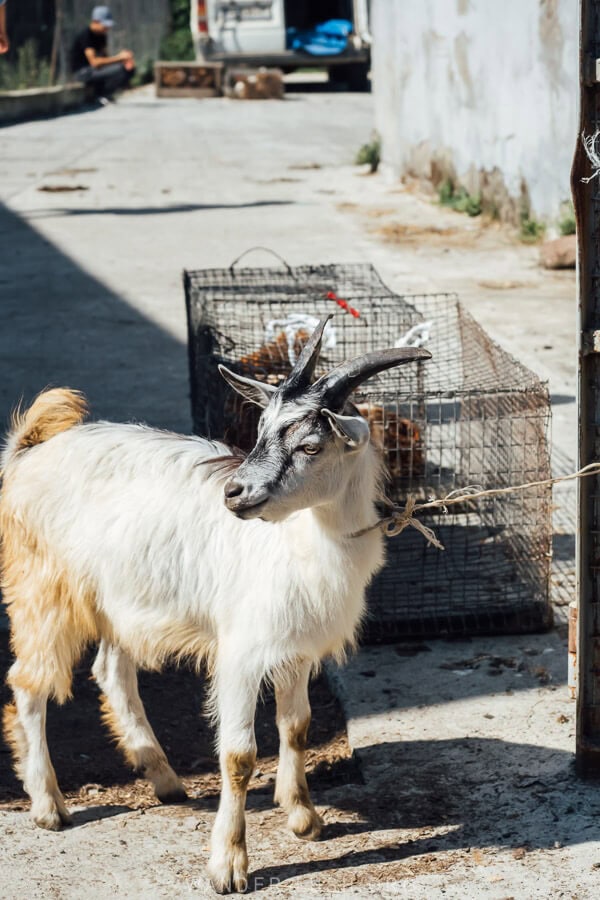
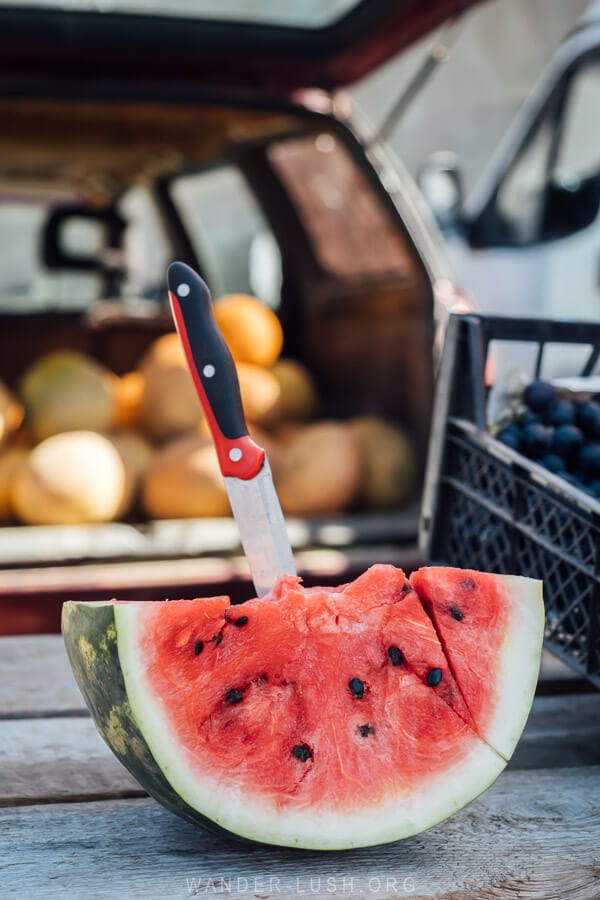
For a moment I felt like I was back in Asia. This market has a totally different feel to many others, and the blue and red tarpaulins and umbrellas make it feel more like a Vietnamese wet market than a Georgian bazaar.
There are more than 60 villages in Chokhatauri Municipality, and I reckon most people descend on the town for the market. It was pulsating when we visited in August. Safe to assume that we were the only tourists that day. People greeted us with an outward friendliness I have not experienced recently in Georgia – someone even gifted me a watermelon!
Photograph the mosaics in Chaisubani (Jvartskhma)
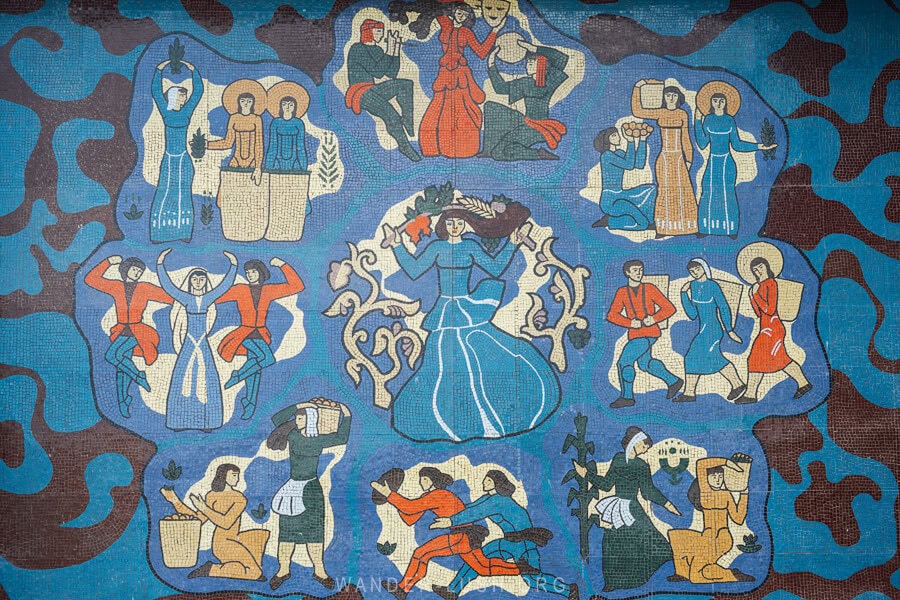
The village of Chaisubani (named after one of the area’s main crops, tea) is located on the road to Bakhmaro. It is little more than a tight cluster of houses and buildings, but there are some real gems among them for fans of Soviet-era architecture and art.
The first is the former Chaisubani House of Culture, which sports a brilliant two-storey mosaic on its front facade (pictured above). People working fields of tea, citrus and corn are depicted alongside traditional dancers and two men playing a game of burti. The ultramarine background is quite unique.
Directly opposite, the small and newly completed Chaisubani Church is set on the grounds of the old WWII memorial. It’s very unusual to see a mix of Soviet-era and Orthodox architecture in one place, so this is quite unique.
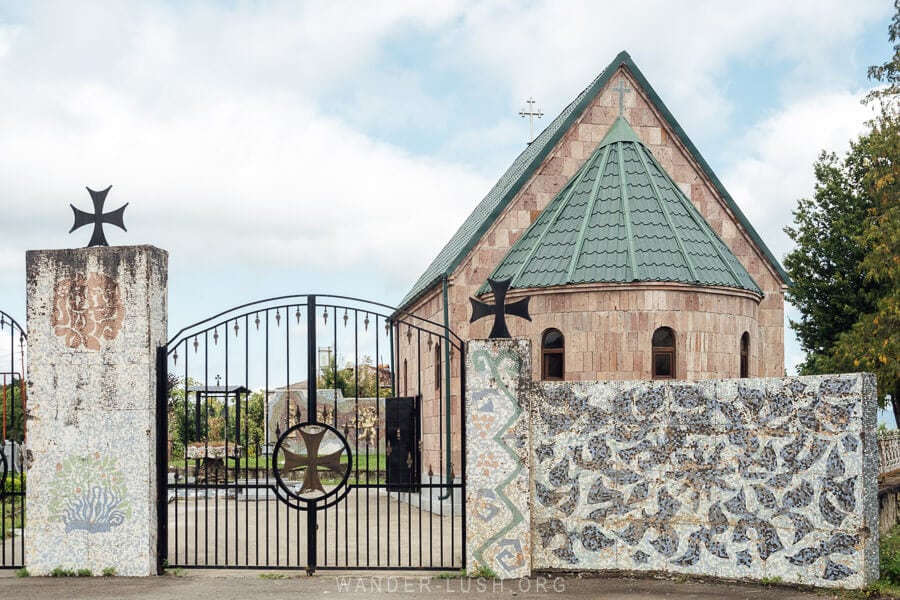
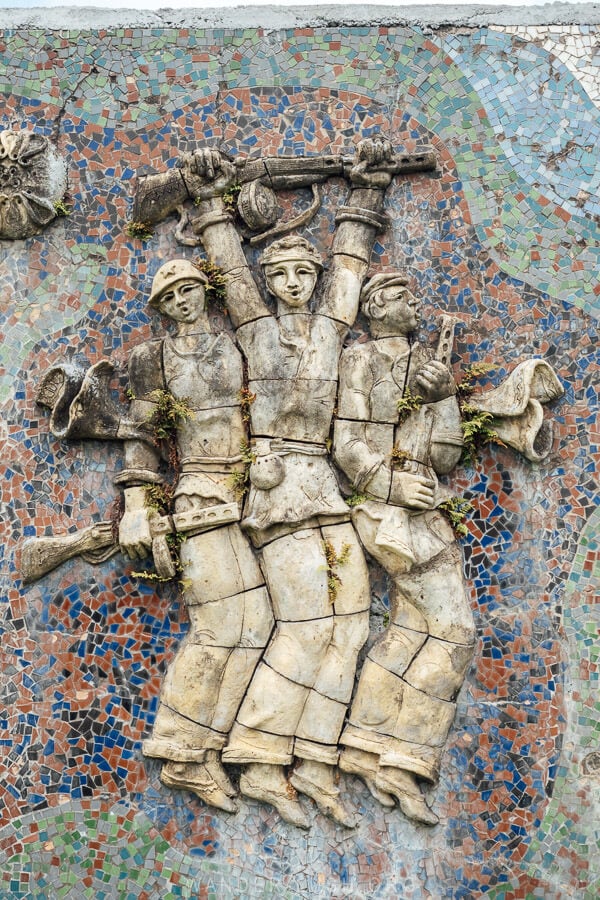
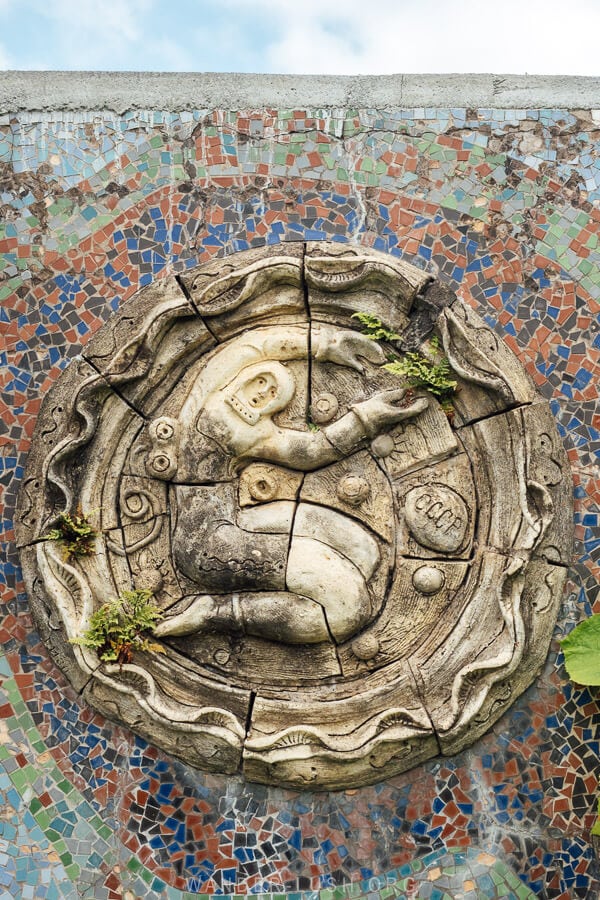
Everything from the church gates to the big empty fountain is covered in mosaics. The memorial itself combines tile mosaics and sculptural reliefs, depicting more industrial motifs (including tea pickers) along with victorious soldiers and typical Soviet imagery, including a cosmonaut dressed in his CCCP livery.
Visit the Nodar Dumbadze Museum
Located off the highway in Akhalsheni village, this house museum is dedicated to the Georgian writer Nodar Dumbadze. We ran out of time and I was sorry to miss this one – but I will be back on a future visit.
The museum is open every day between 10am-6pm and is free to visit.
Drink Nabeghlavi mineral water direct from the spring
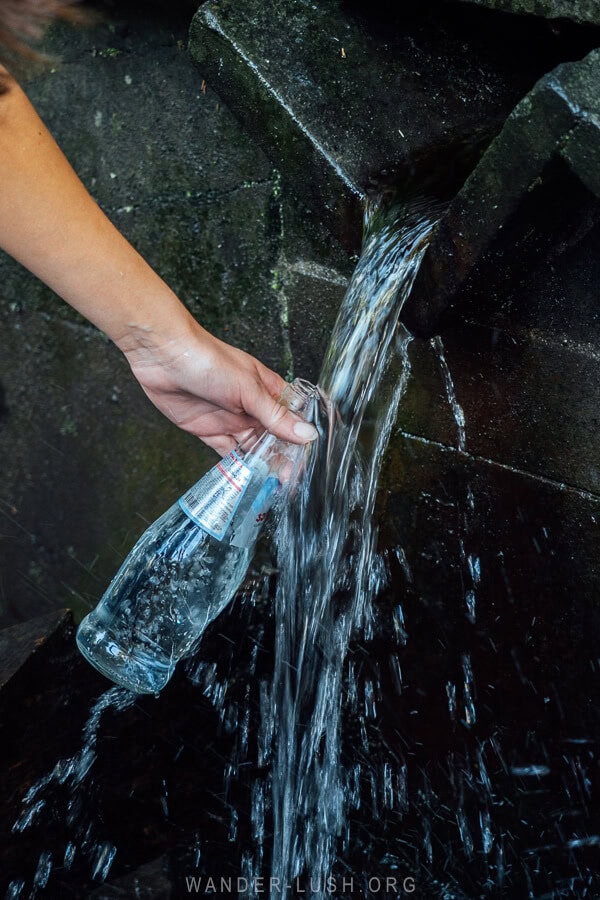
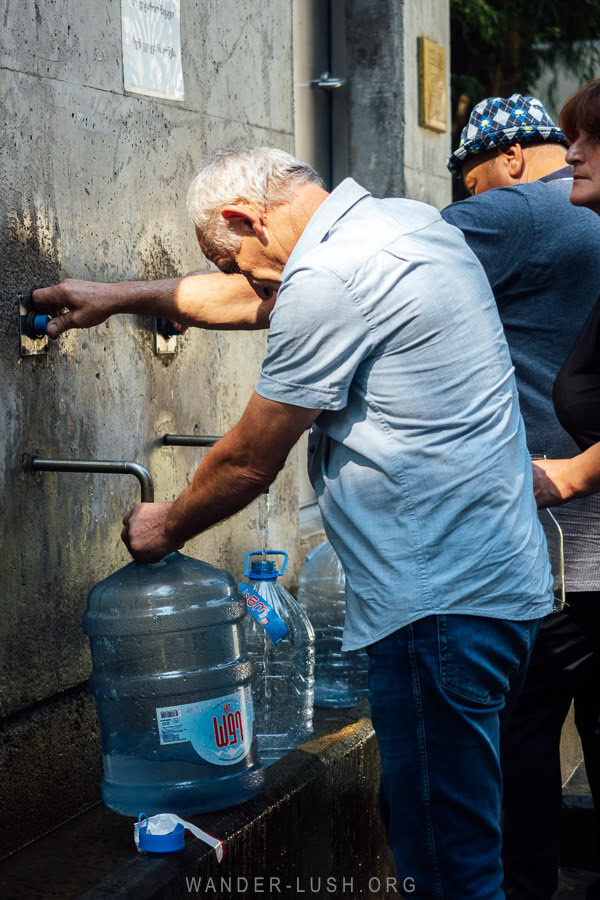
Those in the know will tell you that Nabeghlavi mineral water is far superior to the more-famous Borjomi (it is my personal favourite, after all). This spring off the Bakhmaro Road is an obligatory stop for locals and a great little local experience.
Driving up the mountain, you will pass the Nabeghlavi factory on your right. Take the turn immediately after the last building to cross the little bridge over the river. You will see a big parking area.
The public spring is located on the Nabeghlavi factory grounds. Known as Borehole 2K, it was drilled in 1988 at a depth of 180 metres. A never-ending supply of mineral-rich water emanates from the spring, dispensed via two taps placed in the side of a concrete structure. Try a glass, or do like the locals do and fill up a big bottle with the water.
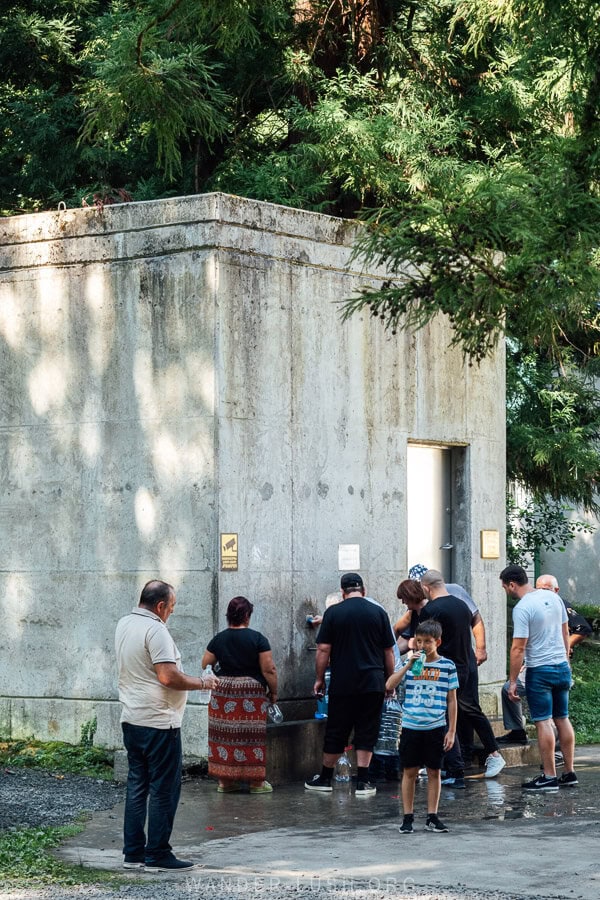
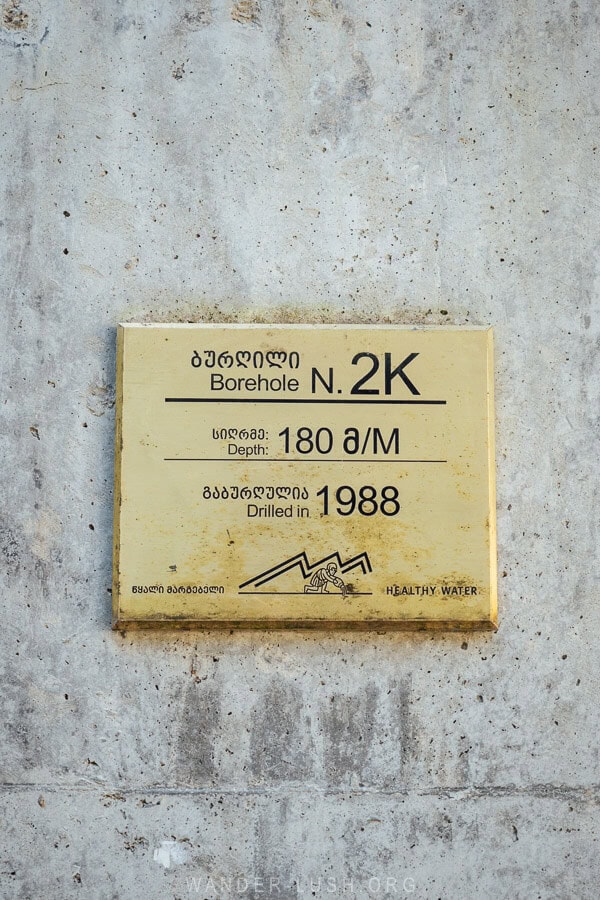
The taste is nothing like bottled Nabeghlavi. It is only slightly effervescent, a bit metallic but still refreshing. It will stay good for a couple of days as long as you keep it out of direct sunlight.
Where to stay in Bakhmaro
Accommodation in Bakhmaro is mostly limited to cabins. There are a couple of hotels, including Pioneers and the well-regarded Panorama Bakhmaro.
Cabins and rooms book up during summer, so you will need to reserve in advance if you are travelling in the high season.
We didn’t stay in Bakhmaro – we chose to drive back down the mountain and return to our favourite accommodation in Ozurgeti, Menabde Winery.
Bakhmaro travel tips
- There is one Bank of Georgia ATM in Bakhmaro, located at Pioneers.
- Amenities in Bakhmaro are very basic. There are a few small grocery stores (markets), and a pharmacy.
- There is no gas station in Bakhmaro so remember to fill up your tank in Chokhatauri if you are self-driving.
- Magti has good coverage in Bakhmaro, but on the day of the Bakhmaro Cup neither Ross nor I could get online. I think the sheer number of people drained the network. WIFI is available at Pioneers.
- The resort itself has no water supply, but most cabins have tanks.
Travel Georgia Like a Pro
Planning a trip to Georgia? Here are 5 essential resources that I recommend you check out.
- For private transfers in Georgia: GoTrip.ge. Find a professional, English-speaking driver. Prices are locked in when you book & you can stop wherever you want.
- For hiring a car in Georgia: Local Rent. Save money when you rent directly from a local agent. Pick-up & drop-off are available from any address in Georgia.
- For finding accommodations: Booking.com. This website has the biggest selection of properties in Georgia, including guesthouses in rural areas.
- For Tbilisi tours & day trips: Friendly.ge. Friendly.ge has knowledgeable guides, safe drivers & creative itineraries. I especially like their off-road tour to David Gareja.
- For tailored advice: Book a call with me! My Georgia Travel Consultation service is perfect if you need feedback on your itinerary or personalised travel tips.



